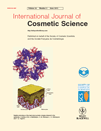
INTERNATIONAL JOURNAL OF COSMETIC SCIENCE
Scope & Guideline
Illuminating the Path to Skin Health
Introduction
Aims and Scopes
- Formulation Science and Innovative Ingredients:
Research on the development of new cosmetic formulations, including the use of novel ingredients, emulsifiers, and delivery systems to enhance product efficacy and user experience. - Skin and Hair Biology:
Studies exploring the biological mechanisms affecting skin and hair, including cellular and molecular responses to various treatments, the role of the microbiome, and the impact of environmental factors. - Clinical Efficacy and Safety Assessments:
Evaluation of the safety and effectiveness of cosmetic products through clinical trials, consumer studies, and objective measurements of skin and hair parameters. - Sustainability and Eco-friendliness:
Research focused on sustainable practices in cosmetic formulation, including the use of natural ingredients, eco-friendly packaging, and the environmental impact of cosmetic products. - Consumer Perception and Sensory Evaluation:
Studies examining how consumers perceive cosmetic products, including sensory attributes and emotional responses, and how these perceptions influence product usage and satisfaction. - Regulatory and Safety Issues:
Analysis of regulatory frameworks governing cosmetic products, including safety assessments, labeling requirements, and compliance with international standards.
Trending and Emerging
- AI and Digital Tools in Cosmetic Science:
There is a growing trend of utilizing artificial intelligence and digital tools for product evaluation, clinical grading, and consumer engagement, indicating a shift towards data-driven approaches in cosmetic research. - Sustainable and Green Chemistry:
Research into sustainable ingredients and environmentally friendly formulations is increasingly prevalent, driven by consumer demand for eco-conscious products and the industry's commitment to sustainability. - Microbiome Research:
The role of the skin and scalp microbiome in health and beauty is emerging as a critical area of study, with increased interest in how products can support or alter microbial communities for better skin and hair health. - Personalized Skincare Solutions:
There is an increasing focus on personalized skincare, where products are tailored to individual needs based on genetic, environmental, and lifestyle factors, reflecting a broader trend towards customization in beauty. - Advanced Delivery Systems:
Research on novel delivery systems, such as nanotechnology and microneedles, is gaining momentum, enhancing the efficacy of active ingredients and improving consumer experiences with cosmetic products.
Declining or Waning
- Traditional Synthetic Ingredients:
Research on conventional synthetic ingredients is decreasing as the industry shifts towards natural and sustainable alternatives. There is a growing demand for greener formulations and natural product validation. - Generalized Anti-Aging Claims:
Studies making broad anti-aging claims without robust scientific backing are becoming less frequent. The focus is shifting towards specific mechanisms and targeted solutions, backed by clinical evidence. - Basic Formulation Techniques:
Basic formulation techniques that do not incorporate advanced technologies or innovative ingredients are seeing reduced interest, as researchers and formulators seek to explore more sophisticated approaches. - General Hair Care Products:
Research focusing solely on general hair care products without addressing specific issues or advancements in technology is declining. There is a shift towards targeted treatments that address specific hair conditions or concerns. - Non-Clinical Efficacy Studies:
There is a waning interest in non-clinical studies that do not contribute significantly to understanding product efficacy or safety. The emphasis is now on clinically relevant results and real-world applications.
Similar Journals
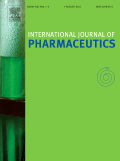
International Journal of Pharmaceutics
Shaping the future of pharmacy through quality research.The International Journal of Pharmaceutics, a prestigious publication from ELSEVIER, stands at the forefront of the pharmaceutical science field, exemplified by its impressive ranking of #15 out of 183 in Pharmacology, Toxicology, and Pharmaceutics, placing it in the 92nd percentile. Established in 1978, this journal has continuously provided a platform for researchers, professionals, and students to share groundbreaking discoveries and innovations in drug formulation, delivery systems, and pharmacokinetics. With a Q1 ranking in the 2023 category of Pharmaceutical Science, it underscores its significance in disseminating high-quality research that shapes clinical practices and enhances therapeutic outcomes. While the journal does not currently offer open access options, it remains accessible to subscribers through its publication based in Amsterdam, Netherlands, ensuring a broad reach within the scientific community. As it converges towards a vibrant future, the International Journal of Pharmaceutics continues to be an essential resource for anyone dedicated to advancing the field of pharmacy and drug development.

FOOD AND DRUG LAW JOURNAL
Advancing Knowledge in Food and Drug LawFOOD AND DRUG LAW JOURNAL is a vital publication dedicated to the intersection of law, public health, and pharmaceutical regulations. Established by the Food Drug Law Institute, this journal serves as an essential resource for legal practitioners, regulatory officials, and researchers focused on the complexities of food and drug legislation. While the journal has not yet achieved open access status, it remains a respected platform for scholarly discourse, reflected in its H-Index and quartile rankings, which place it in Q3 for Law and Q4 in several other relevant fields. Covering diverse topics related to the legal frameworks governing food and drug safety from 1992 to 2018 and continuing its impactful publication from 2021 to 2023, this journal provides critical insights into emerging legal challenges and compliance assurance in the domains of pharmacology and public health. As a publication with a distinct focus on these specialized areas, it aims to advance understanding and influence policy-making, making it a significant asset for professionals and academics alike.
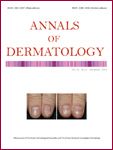
Annals of Dermatology
Connecting researchers and clinicians for skin health advancements.Annals of Dermatology is a prestigious academic journal published by the Korean Dermatological Association, focusing on the latest research and advancements in the field of dermatology. With a commitment to advancing knowledge in skin health and disease, this journal serves as a vital resource for researchers, clinicians, and students working in dermatology and related disciplines. Since its inception in 1989, it has evolved to consolidate its position in the academic community, boasting a Q2 ranking in the 2023 Dermatology category and a Scopus rank of #87 out of 142, placing it in the 39th percentile. Although it operates under a subscription model, the journal's impact factor reflects its significance in advancing dermatological research, attracting innovative studies and reviews that shape clinical practice. With a publication history extending from 1989 to 1996 and then from 2008 to the present, Annals of Dermatology continues to be an essential publication for those devoted to improving skin health.

International Journal of Gastronomy and Food Science
Unveiling the Cultural Significance of Food Through ResearchThe International Journal of Gastronomy and Food Science, published by ELSEVIER, serves as a premier platform for scholars and practitioners in the domains of gastronomy and food science. With an ISSN of 1878-450X and E-ISSN 1878-4518, this journal has been recognized for its impact, holding a prestigious Q1 ranking in Cultural Studies and a Q2 ranking in Food Science as of 2023, thereby reflecting its influence and relevance in the field. It is particularly noted for its robust Scopus rankings, placing 28th out of 1304 in Social Sciences - Cultural Studies, advocating for high-quality research with a 97th percentile ranking, and 117th in Agricultural and Biological Sciences – Food Science with a 70th percentile ranking. This open-access journal offers a comprehensive exploration of food-related issues, aiming to bridge the gap between culinary arts and scientific research, enhancing the understanding of food systems and cultural significance. For researchers, professionals, and students alike, the International Journal of Gastronomy and Food Science is an invaluable resource, dedicated to fostering innovation and comprehensive discourse in culinary studies.
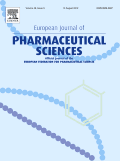
EUROPEAN JOURNAL OF PHARMACEUTICAL SCIENCES
Advancing Pharmaceutical Knowledge for a Healthier TomorrowThe European Journal of Pharmaceutical Sciences is a prestigious academic journal dedicated to advancing the field of pharmaceutical science. Published by Elsevier, the journal boasts an impressive impact factor and is categorized in the Q1 quartile for pharmaceutical science as of 2023, signifying its influence and reputation within the academic community. With a Scopus ranking of #20 out of 183 in the fields of pharmacology, toxicology, and pharmaceutics, the journal provides a vital platform for researchers and practitioners to disseminate innovative studies and groundbreaking research that push the boundaries of drug development and delivery. Based in the Netherlands and operating since 1993, the journal seeks to cover a broad scope of topics related to pharmaceutical sciences, encouraging rigorous evaluations and discussions that enhance the understanding and application of this critical field. The absence of open access underscores the commitment to maintaining high scholarly standards, while still offering avenues for libraries and institutions to provide access to cutting-edge research. As the journal converges towards its 2024 milestones, it continuously aims to foster a vibrant exchange of knowledge among its diverse readership, comprising committed researchers, professionals, and students.

Journal of Dermatology & Dermatologic Surgery-JDDS
Empowering Dermatology Through Collaborative ResearchJournal of Dermatology & Dermatologic Surgery (JDDS) is a premier open access journal published by Wolters Kluwer Medknow Publications since 2018. This journal serves as a vital platform for the dissemination of cutting-edge research and advancements in the field of dermatology and dermatologic surgery. With its ISSN 2352-2410 and E-ISSN 2352-2429, JDDS strives to present high-quality articles that encompass clinical studies, innovative surgical techniques, and comprehensive reviews, thereby catering to the interests of researchers, medical professionals, and students alike. The journal has gained recognition within the academic community, evidenced by its Scopus ranks, placing it 237th out of 551 in the Medicine - Surgery category and 70th out of 142 in Medicine - Dermatology. The open access model not only enhances visibility but also encourages global collaboration and knowledge sharing in the rapidly evolving field of dermatology. Targeting the needs of diverse audiences, JDDS continues to foster an environment for scholarly communication and contributes significantly to the advancement of dermatologic sciences.
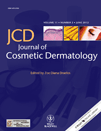
Journal of Cosmetic Dermatology
Transforming Skin Health Through Research and InsightJournal of Cosmetic Dermatology, published by WILEY, stands as an influential platform in the field of dermatology, specifically focusing on cosmetic interventions and skin health. With its ISSN 1473-2130 and E-ISSN 1473-2165, this journal caters to a global audience, offering high-quality research and reviews that bridge the gap between scientific innovation and clinical practice. Ranked in the 74th percentile within the dermatology field, the journal occupies a notable position at Q2 in category rankings, reflecting its commitment to excellence and relevance in the cosmetic dermatology landscape. The journal encourages submissions that advance the knowledge of skin conditions, designs of cosmetic treatments, and patient care strategies, providing both researchers and practicing dermatologists with the insights needed to enhance clinical outcomes. Despite being a subscription-based platform, readers can engage deeply with a wealth of scholarly articles from 2002 through the present, which underscores its longstanding contribution to dermatological science.
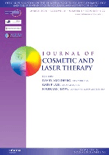
Journal of Cosmetic and Laser Therapy
Elevating Standards in Cosmetic and Laser Therapy ResearchThe Journal of Cosmetic and Laser Therapy, published by TAYLOR & FRANCIS INC in the United Kingdom, serves as a vital resource for professionals, researchers, and students in the fields of dermatology, surgery, and cosmetic medicine. Since its inception in 1999, this peer-reviewed journal has sought to advance knowledge and practice in the burgeoning fields of cosmetic and laser treatments, offering a platform for scholarly articles that explore novel techniques, clinical outcomes, and emerging trends. With an impressive categorization in the 2023 Quartiles showcasing its influence—Q3 in Dermatology and Medicine, and Q2 in Surgery—the journal reflects a commendable impact within the community. Although not an Open Access journal, it provides access to essential information and rigorous research that aids in the development and refinement of treatment protocols. The Scopus ranks further emphasize its significance, particularly in Medicine and Surgery, where it holds positions in the 57th and 52nd percentiles respectively—underscoring its commitment to quality and relevance. As the landscape of cosmetic treatments continues to evolve, the Journal of Cosmetic and Laser Therapy remains an indispensable reference for those looking to stay at the forefront of advancements in this dynamic field.

AESTHETIC PLASTIC SURGERY
Transforming Aesthetics, Elevating SurgeryAesthetic Plastic Surgery, published by Springer, is a premier journal dedicated to advancing the field of cosmetic and reconstructive surgery. Since its inception in 1976, the journal has established itself as a vital resource for surgeons, researchers, and medical professionals, achieving a remarkable H-Index and ranking in the top percentile for surgery disciplines within Scopus. With an impressive impact factor and categorized in the Q1 quartile for Surgery, this journal is committed to publishing high-quality articles that encompass a wide array of topics within aesthetic procedures, innovative techniques, and patient outcomes. Although it does not offer open access, the journal remains pivotal for those seeking to stay updated with the latest research, trends, and practice modalities in aesthetic surgical care. With a global reach, catering to scholars from the United States and beyond, Aesthetic Plastic Surgery is an invaluable asset for anyone immersed in the transformative realm of plastic surgery.

TROPICAL JOURNAL OF PHARMACEUTICAL RESEARCH
Fostering breakthroughs in drug development and application.Tropical Journal of Pharmaceutical Research is an esteemed open-access platform dedicated to advancing the field of pharmaceutical sciences, published by the Pharmacotherapy Group in Nigeria. With an ISSN of 1596-5996 and open access established since 2002, this journal serves as a critical resource for researchers, professionals, and students seeking to disseminate and access high-quality research in both pharmaceutical science and pharmacology. Despite its ranking in the third quartile (Q3) for Pharmaceutical Science and the fourth quartile (Q4) in Pharmacology as of 2023, the journal continues to stand out with its commitment to fostering significant dialogue and innovation in the scientific community. Anchored at the University of Benin, Faculty of Pharmacy, the journal invites contributions that explore novel pharmaceutical research, clinical applications, and drug development, playing a vital role in addressing health challenges that are particularly relevant to tropical regions. Researchers can look forward to publishing their findings in a journal that not only promotes the sharing of knowledge but also enhances the scientific discourse within a rapidly evolving field.